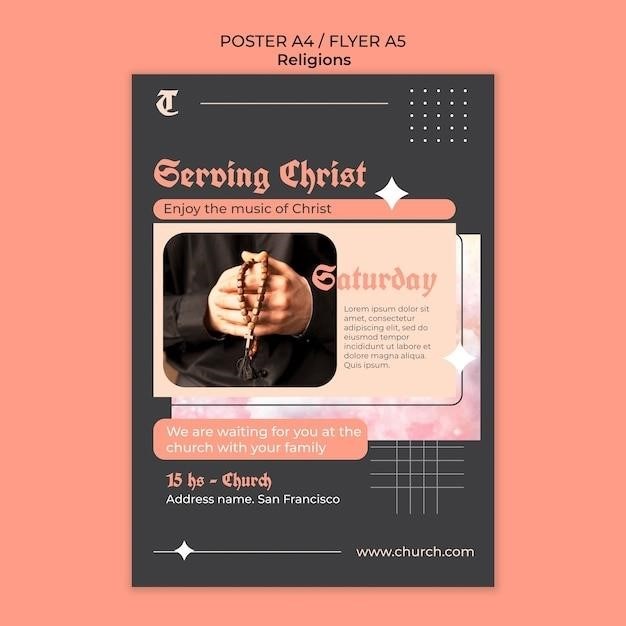Shabbat Prayers⁚ A Guide to the Weekly Sabbath Observance
Shabbat, the Jewish Sabbath, is a day of rest and spiritual renewal, observed from sunset on Friday to sunset on Saturday. Shabbat prayers are an integral part of this observance, offering a framework for reflection, gratitude, and connection with the divine. This guide provides an overview of the various Shabbat prayers, their significance, and resources for deepening your understanding and practice.
Introduction⁚ The Significance of Shabbat
Shabbat, the Jewish Sabbath, holds a central place in Jewish tradition, representing a weekly pause from the demands of daily life and a time for spiritual renewal. The observance of Shabbat, encompassing both rituals and reflections, serves as a reminder of God’s creation and the importance of rest and connection. Shabbat prayers, a core element of the observance, guide individuals and communities through a journey of gratitude, contemplation, and celebration.
The Shabbat experience is rooted in the biblical commandment to “Remember the Sabbath day, to keep it holy,” found in the Book of Exodus. This commandment calls for a day of rest, a cessation of work, and a dedication to spiritual and communal activities. The observance of Shabbat extends beyond mere physical rest, encompassing a commitment to mindful living, family time, and acts of kindness.
Shabbat prayers, recited in synagogues and homes, serve as a focal point for the Shabbat experience. They provide a structured framework for connecting with the divine, expressing gratitude, and acknowledging the sanctity of the day. From the traditional blessings over candles and wine to the recitation of Psalms and the Amidah, Shabbat prayers offer a rich tapestry of spiritual expression.
Kabbalat Shabbat⁚ Welcoming the Sabbath
Kabbalat Shabbat, meaning “welcoming the Sabbath,” marks the beginning of the Shabbat observance, ushering in a time of spiritual peace and joy. This special service, traditionally held on Friday evening as the sun sets, serves as a transition from the week’s activities to the sacred space of Shabbat.
The Kabbalat Shabbat service is filled with prayers, songs, and rituals designed to create a sense of anticipation and welcome for the Sabbath. It is a time to set aside worldly concerns and embrace the opportunity for spiritual connection. The service often begins with the lighting of Shabbat candles, a symbolic act that brings light and warmth to the home and signifies the arrival of the Sabbath.
The recitation of blessings, such as the Kiddush, over a cup of wine, marks the official beginning of Shabbat. Kiddush, meaning “sanctification,” acknowledges the holiness of the day and sets the tone for a Shabbat meal shared with loved ones. The service also includes the singing of traditional Shabbat hymns, such as “Shalom Aleichem,” which welcomes the Shabbat angels into the home and evokes a sense of peace and tranquility.
Kabbalat Shabbat is a time for reflection and preparation for the Sabbath experience. It is an opportunity to create a sacred space within the home and to welcome the blessings and peace that Shabbat brings.
Shabbat Morning Prayers⁚ Structure and Content
Shabbat morning prayers, often referred to as Shacharit, are a central part of the Shabbat observance. These prayers offer a unique and enriching experience, building upon the foundation laid in the Kabbalat Shabbat service. The Shabbat morning service incorporates elements of the daily prayer service, but with specific additions and modifications that reflect the special nature of the Sabbath.
The structure of the Shabbat morning service generally follows a pattern⁚ preparatory prayers and readings, the Shema and its blessings, the Amidah (a set of 18 blessings), and concluding sections. The service may also include the reading of the Torah portion, a key element of Jewish worship.
The content of Shabbat morning prayers encompasses a wide range of themes. Prayers of praise and gratitude for the creation and the gift of Shabbat are prominent, alongside expressions of faith and devotion. The Shema, a declaration of faith in the unity of God, is a central part of the service. The Amidah, a cornerstone of Jewish prayer, addresses a variety of themes, including the needs of the community, the pursuit of justice, and the hope for redemption.
Shabbat morning prayers offer a rich and meaningful experience, connecting individuals to the tradition and deepening their spiritual connection. The prayers serve as a reminder of the special nature of the Sabbath and its importance in Jewish life.
Shabbat Afternoon Prayers⁚ Uva LTzion and Other Readings
While the morning service is a centerpiece of Shabbat observance, the afternoon also holds a special place for prayer and reflection. Shabbat afternoon prayers offer a unique opportunity to delve deeper into themes of redemption, hope, and longing for the messianic era. A key element of these prayers is the recitation of “Uva LTzion,” a prayer for redemption deeply rooted in the Tanakh.
Uva LTzion, often sung to a special melody, is a powerful prayer that expresses yearning for the restoration of the Temple and the coming of the Messiah. It draws heavily from biblical verses, evoking images of angels proclaiming God’s glory and reminding us of God’s mercy. The prayer also calls upon God to direct our hearts towards holiness and emphasizes the hope for a future filled with peace and righteousness;
Beyond Uva LTzion, other readings and prayers may be included in the Shabbat afternoon service. These might include Psalms, prayers for peace and well-being, or selections from the Prophets. This time of prayer provides a reflective pause in the midst of the Sabbath, offering a space for contemplation and connection with the divine.
The Shabbat afternoon prayers, with their emphasis on longing for redemption and the messianic age, offer a profound reminder of the enduring hope and faith that lie at the heart of Jewish tradition.
Shabbat Evening Prayers⁚ Concluding the Sabbath
As the Shabbat draws to a close, the evening prayers serve as a beautiful and poignant conclusion to the day of rest. These prayers acknowledge the transition from the sanctity of Shabbat to the ordinary week, while also expressing gratitude for the blessings received during the day.
One of the most significant prayers of the Shabbat evening service is Havdalah, a ceremony that marks the official end of the Sabbath; Havdalah is performed with a special blessing over wine, spices, and a braided candle, symbolizing the separation of the holy from the mundane. The unique aroma of the spices and the flickering flame of the candle serve as a reminder of the special atmosphere of Shabbat, even as we transition back to our daily lives.
In addition to Havdalah, Shabbat evening prayers often include Psalms, prayers of thanks, and reflections on the meaning of Shabbat. They provide an opportunity to express gratitude for the spiritual nourishment received during the day and to seek guidance and strength for the week ahead. The evening prayers are a time for quiet reflection and contemplation, allowing us to carry the spirit of Shabbat into the coming week.
The Shabbat evening prayers, with their focus on gratitude, reflection, and transition, serve as a powerful reminder that the spirit of Shabbat can remain with us throughout the week, guiding us towards a life of purpose and meaning.
Shabbat Prayer Books⁚ Resources for Personal and Communal Practice

Shabbat prayer books, known as Siddurs, are essential resources for both personal and communal Shabbat observance. They contain the texts of the various prayers, blessings, and readings used during the Shabbat services, providing a comprehensive guide for the spiritual journey of the day. Siddurs are available in a wide range of styles, reflecting different denominations and traditions within Judaism.
Some Siddurs focus on traditional liturgy, offering a comprehensive collection of prayers and readings with Hebrew and English translations. Others emphasize modern interpretations and contemporary language, making the prayers accessible to a wider audience. There are also specialized Siddurs for specific needs, such as those designed for families with young children, or for individuals seeking a more contemplative Shabbat experience.
The choice of a Siddur is a personal one, reflecting individual preferences and spiritual needs. Whether you are seeking a traditional prayer book or a more modern approach, there is a Siddur available to guide you through the beautiful and meaningful prayers of Shabbat.
In addition to printed Siddurs, online resources and digital platforms offer convenient access to Shabbat prayers. These resources provide flexibility and convenience, allowing individuals to access prayers and readings from anywhere with an internet connection. Many online platforms also offer interactive features, such as audio recordings and transliterations, enhancing the experience of prayer and study.
Shabbat Blessings⁚ Kiddush and Havdallah
Shabbat blessings, known as Kiddush and Havdallah, mark the beginning and end of the Sabbath, respectively. These blessings serve as symbolic rituals, invoking the holiness of Shabbat and guiding the transition between the sacred and the mundane.
Kiddush, recited over a cup of wine, is a blessing that sanctifies the Sabbath. It is typically performed at the beginning of the Shabbat meal, marking the official commencement of the day of rest. The Kiddush blessing acknowledges God’s creation of the world, and the special significance of Shabbat as a day of rest and holiness.
Havdallah, pronounced over a braided candle, spices, and wine, marks the end of Shabbat. It distinguishes between the sacred time of Shabbat and the ordinary days of the week. The Havdallah blessing praises God for the separation of the holy from the profane, and for the gift of Shabbat.
The blessings of Kiddush and Havdallah are often accompanied by traditional rituals and customs, such as the lighting of Shabbat candles before Kiddush, and the smelling of spices during Havdallah. These rituals enhance the symbolic and spiritual significance of the blessings, creating a meaningful and memorable experience.
Kiddush and Havdallah are powerful reminders of the unique sanctity of Shabbat. They provide a framework for gratitude, reflection, and the transition between the sacred and the everyday, enriching the Shabbat experience and strengthening the connection to tradition.
Shabbat Songs and Melodies⁚ Enhancing the Sabbath Experience
Shabbat songs and melodies are a cherished tradition, adding a vibrant layer of joy and spirituality to the Sabbath observance. These songs, known as Zemirot, are a blend of ancient and modern compositions, reflecting the rich history and diverse expressions of Jewish culture.
From the traditional melodies of Shalom Aleichem, welcoming the Sabbath angels, to the uplifting tunes of Lecha Dodi, ushering in the Sabbath Queen, Shabbat songs create an atmosphere of warmth and celebration. The melodies often carry deep symbolism, expressing themes of gratitude, peace, and the joy of Shabbat.
Many Shabbat songs are sung during the Shabbat meals, adding a musical dimension to the gathering of family and friends. The melodies can be sung in unison, with individuals taking turns leading, or in a more formal setting with a cantor or choir.
Shabbat songs have a powerful ability to connect generations, fostering a sense of continuity and shared heritage. They are often passed down through families, with each generation adding its own unique interpretation and meaning.
Shabbat melodies not only elevate the spiritual dimension of the Sabbath, but they also serve as a powerful tool for building community. Singing together creates a sense of unity and shared purpose, strengthening bonds and fostering a sense of belonging.
The inclusion of Shabbat songs in the observance enriches the experience, creating a tapestry of sound and spirituality that resonates with the heart and soul, reminding us of the beauty and enduring legacy of the Jewish tradition.

Shabbat Observance⁚ Beyond the Prayers
Shabbat observance extends far beyond the recitation of prayers. It encompasses a rich tapestry of traditions and practices that create a unique and meaningful experience. These practices serve as a tangible expression of the Sabbath’s spiritual essence and foster a deeper connection to its principles.
The act of lighting Shabbat candles, a ritual performed before the start of Shabbat, symbolizes the bringing of light into the home and the welcoming of the Sabbath spirit. Similarly, the Kiddush, a blessing recited over wine, marks the official beginning of the Sabbath and reminds us of God’s creation of the world.
Shabbat meals are a central element of the observance, providing a time for family and friends to gather, share stories, and enjoy delicious food. The meals are often characterized by a special Shabbat challah, a braided bread that symbolizes the interconnectedness of the Jewish people.
Beyond the traditional rituals, Shabbat observance encourages a conscious shift in mindset and behavior. It is a time to disconnect from the demands of the workweek and engage in activities that nourish the soul, such as spending time with loved ones, enjoying nature, or pursuing creative endeavors.
Shabbat also emphasizes acts of kindness and hospitality, encouraging individuals to extend a welcoming hand to others and share the joy of the Sabbath. This spirit of generosity and compassion reinforces the values of community and shared responsibility.
Shabbat observance is a dynamic and evolving tradition, with each individual and community finding unique ways to express its essence. Whether through traditional rituals or personal practices, the goal remains the same⁚ to create a space for spiritual reflection, connection, and the cultivation of a more meaningful and fulfilling life.
